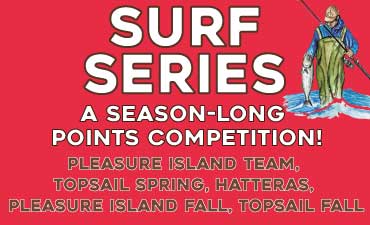Releases – October 25, 2018
The Standard Commercial Fishing License Eligibility Board to the N.C. Division of Marine Fisheries will meet at 10:30 a.m., Oct. 30 at the N.C. Department of Environmental Quality’s Washington Regional Office, 943 Washington Square Mall, Highway 17, Washington.
The board will consider applications deemed complete and that were submitted by Sept. 10.
The board meets two to three times a year to consider license applications.
For directions on applying for a commercial fishing license, go to http://portal.ncdenr.org/web/mf/commercial-fishing-license-information and click on the Eligibility Pool Application link.
For more information, contact division License Eligibility Clerk Ann Bordeaux-Nixon at (910) 796-7261 or Ann.Bordeaux-Nixon@ncdenr.gov.
The N.C. Marine Fisheries Commission Nominating Committee will meet at 4:00 p.m. on Oct. 29 at the N.C. Division of Marine Fisheries’ Headquarters, 3441 Arendell St., Morehead City.
The committee will consider and select candidates for nomination to the South Atlantic Fishery Management Council obligatory seat.
For more information, contact Nancy Fish in the Marine Fisheries Commission office at (252) 808-8021 or Nancy.Fish@ncdenr.gov.
The Elizabeth City office of the N.C. Division of Marine Fisheries will close beginning Oct. 11 to allow staff to move to a new office location.
The division will announce when the new office at 100 Kitty Hawk Lane, Elizabeth City reopens. The new office is off Industrial Park Drive and about 6.7 miles from the old office on Impact Boulevard.
Members of the public seeking commercial fishing licenses, recreational hunting or fishing licenses, or boat registrations while the Elizabeth City office is closed may go to:
N.C. Department of Environmental Quality’s Washington Regional Office
943 Washington Square Mall, Washington
(252) 946-6481
Division of Marine Fisheries’ Manteo Field Office
1021 Driftwood Drive, Manteo
(252) 473-1223
Additionally, Coastal Recreational Fishing Licenses may be purchased at many sporting goods and bait and tackle shops; online at www.ncwildlife.org; or by phone, Monday through Friday, 8:00 a.m. to 5:00 p.m., at (888) 248-6834.
Division staff in the Elizabeth City office may be reached through the Washington Office at (252) 946-6481 or by email.
With technology affecting every aspect of our lives, from the way we work and live at home and even to the way we recreate, it’s no wonder it’s also making an impact on old-time American pursuits such as recreational fishing. That impact may be a little slower in coming for many—but not all. Results from a recent survey at AnglerSurvey.com reveal that while 85 percent of active anglers own a smartphone, only 25 percent of those anglers use apps related to fishing.
With so many owning smartphones, not making better use of helpful apps such as solunar tables, weather, and tide charts would seem at odds. However, the number one reason cited for not using fishing-related apps is that most, 56 percent, simply don’t recognize the need for one or haven’t realized how apps can help improve their time on the water.
Others, 46 percent, also cited the desire to leave technology behind when fishing, seeking a more basic experience outdoors.
Other top reasons cited included wanting to keep their hands free (20 percent), not realizing fishing-related apps even existed (19 percent), and the fear of losing or damaging their phone (12 percent). Respondents could cite more than one reason in the survey.
But of those 25 percent of anglers who have discovered the benefits of using fishing-related apps, the top choices include Fishing and Hunting Solunar Time (19 percent), Navionics (19 percent), Fish Brain (16 percent), Tide Charts Near Me (11 percent), Fishidy (9 percent), and Tides Near Me (9 percent). Other popular options included Windy, Onx Hunt, and iBobber.
More than 39 percent cited “other” as their favorite apps weren’t listed.
And when were most of these apps used? Seventy-one percent of app-using anglers use them prior to hitting the water, while 53 percent use them while fishing. Only 14 percent make use of them after they are done fishing for the day.
“While the overall number of anglers may not embrace fishing-related apps, trends would suggest this usage will grow over time as more recreational fishermen discover their benefits,” says Rob Southwick, president of Southwick Associates, which designs and conducts the surveys at AnglerSurvey.com, HunterSurvey.com, and ShooterSurvey.com.
The American Sportfishing Association (ASA), a founding member of the Outdoor Recreation Roundtable (ORR), voiced its support for the final report recognizing the outdoor recreation industry as a significant contributor to the U.S. economy.
The report, federally funded by the Departments of the Interior, Agriculture, and Commerce, was released by the Department of Commerce’s Bureau of Economic Analysis (BEA). The new measurement is called the Outdoor Recreation Satellite Account (ORSA). It notes that the outdoor recreation industry has a U.S. GDP contribution of 2.2 percent and an annual gross economic output of $731 billion.
This economic contribution level is greater than other key economic sectors, including the mining, utilities, and chemical products manufacturing industries. In addition, with 4.55 million jobs, the outdoor recreation sector generates similar employment as other major job creators in the United States, including hospitals, transportation and warehousing, and educational services.
Of special note is that recreational fishing and boating contributes $38.2 billion to the annual economy—the largest of the core outdoor recreation activities.
“Today’s final BEA report confirms that outdoor recreation, and recreational fishing and boating in particular, are essential to our economy,” said ASA’s President, Glenn Hughes. “Our nation’s leaders already recognize outdoor recreation’s economic value, and these numbers just help corroborate that. It’s essential that they do everything they can to keep our economy moving forward by expanding access to public lands, modernizing infrastructure, and fostering public-private partnerships.”
The BEA’s analysis also found outdoor recreation to have one of the nation’s strongest wage growth rates, with 4.3 percent. This rate surpasses the overall U.S. wage growth of 2.8 percent during the same period of 2015-2016.
The full report issued by BEA can be found at www.bea.gov/data/special-topics/outdoor-recreation.





